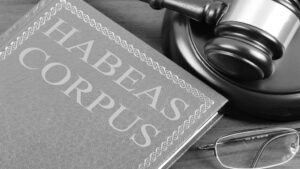Table of Contents
INTRODUCTION
The term “habeas corpus” is Latin for “you shall have the body”, which means that the person being detained has the right to appear before a court or judge and have their detention reviewed. Habeas Corpus is an important writ provided for in the Indian Constitution.
Habeas corpus is a legal term that refers to the right of a person who is being detained by the government or other authority to challenge the legality of their detention before a court or other judicial body
The writ of habeas corpus can be used to challenge the legality of both criminal and civil detentions. If a person is being detained without legal justification, the court may order their release or require that the detaining authority provide a legal basis for the detention.

Origin of Habeas Corpus
The origin of Habeas Corpus can be traced back to 1215 AD when King John signed the landmark document of the Magna Carta.
- The 39th clause of this historical document stated, “No man shall be arrested or imprisoned…except by the lawful judgment of his peers and by the law of the land”.
- The concept of Habeas Corpus is embedded in legal systems all over the world, for instance, in the United States, through the First Judiciary Act of 1789, Congress explicitly authorized the federal courts to grant habeas corpus relief to federal prisoners.
When Habeas Corpus May Lie
The writ of habeas corpus is available as a remedy in all cases of wrongful deprivation of personal liberty. It is a process for securing the liberty of the subjects by affording an effective means of immediate release from unlawful or unjustifiable detention, whether in prison or in private custody. The Constitution confers ample powers on the Supreme Court and all High Courts in the matter of the issue of a writ of habeas corpus.
The right to move the Supreme Court under Article 32 for the enforcement of fundamental rights is itself a fundamental right, while the right to move a High Court under Article 226, though not a fundamental right, is still a constitutional right.
When Habeas Corpus Does Not Lie
In the following cases, a writ of habeas corpus will not lie and will be refused by a court:
- Where the person or authority against whom habeas corpus is sought is not within the territorial jurisdiction of the court;
- Where imprisonment or detention of a person is in accordance with a decision rendered by a court of law or by an authority in accordance with law;
Features of Habeas Corpus
- The writ of habeas corpus primarily acts as a writ of inquiry; it is issued by the courts to ascertain the grounds for the detention of an individual. Therefore, it acts as a procedural safeguard against the law enforcement authorities, specifically their power to take into custody.
- Moreover, if sufficient legal grounds for arrest are missing, the court will order the immediate release of the individual.
- As a fundamental instrument for safeguarding an individual’s freedom against arbitrary and lawless state action, the writ of habeas corpus serves as a procedural device, by which executive, judicial, or other governmental restraints on personal liberty are subjected to judicial scrutiny.
- The Writ of Habeas Corpus is a remedy available to the person who has lost his personal liberty and as such, it cannot be invoked to challenge past illegal detentions.
- However, the Supreme Court has expanded the dimension of this writ and now the Court awards compensation not only for past illegal detentions but also for loss of life as was done in the case of Rudul Shah v. State of Bihar.
Illustration of Habeas Corpus
A has been taken into custody by B a police officer without a warrant. All the efforts made by A’s family to know the whereabouts of A turned out to be futile. As he was detained wrongfully by B (police officer), the writ of habeas corpus can be filed in court by A’s family on his behalf.
res judicata
When it comes to the illegal confinement of a person, the doctrine of res judicata is not applicable. Under Article 32 successive petitions for the writ of habeas corpus can be filed in the court with fresh grounds which were not covered in the earlier petition filed for the same. The petition for habeas corpus is maintainable if it is filed in the forum having its independent existence and separate jurisdiction and competency.
Writ Lies In National Emergency
The writ of habeas corpus is maintainable during an emergency proclamation, as after the 44th amendment in 1978 it was stated that fundamental rights enshrined under articles 20 and 21 cannot be suspended. And for the enforcement of these rights, the writ petition can be filed in court.
Cases
Sunil Batra v. Delhi Administration 1980 AIR 1579
In the instant case, it was held by the court that the writ petition of habeas corpus can be filed in the court not only for the wrongful or illegal confinement of the prisoner but also for his protection from any kind of ill-treatment and discrimination by the authority responsible for his detention. Thus the petition can be filed for unlawful detention and checks how the detention was caused.
Kanu Sanyal v. District Magistrate Darjeeling & Ors. 1974 AIR 510
In the instant case, it was held that instead of following the traditional method of producing the body before the court there must be a complete focus on the legality of the detention by looking into the facts and circumstances of the case. This case majorly focused on the nature and scope of the case and stated that this writ is procedural and not substantive.
MUST READ
5 TYPES OF WRITS IN THE INDIAN CONSTITUTION
